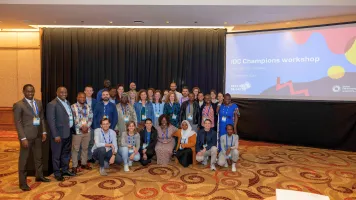This post originally appeared on Development Initiatives on February 14, 2022, and has been posted here with permission. This piece is part of a Global Disability Summit blog series from Inclusive Data Charter Champions.
This week, policymakers will attend the second Global Disability Summit, aimed at promoting the rights of persons with disabilities, the principle of Leave No One Behind and an inclusive recovery from the Covid-19 pandemic. As persons with disabilities are particularly vulnerable to the immediate health risks and secondary effects of the pandemic, these issues have taken on added urgency.
Our discussions with disability advocates in East Africa made clear that using data which captures broad trends and people’s daily realities can be a powerful driver of change. However, this is not easy, not least because disability can be categorised in many different ways.
How to measure disability?
The Washington Group Questions provide a basis for comparable measures of disability status. They are based on the social model of disability in line with a human rights-based approach, emphasising that many disability-related challenges are due to social and environmental factors. However, the Washington Group Questions are not diagnostic, and our assessment of Uganda's disability data landscape found that some stakeholders have reservations about their efficacy, and that the use of different models to collect disability data leads to inconsistencies.
Who and what is counted?
It is important to capture data on people who might be excluded from some sources. For example, individuals with learning disabilities who are institutionalised and may not be included in household surveys. For a full picture, official data should be complemented by unofficial and qualitative sources. However, challenges associated with using such data include quality concerns, inconsistencies across methodologies and its specificity to particular projects, which limits the scope of its use.
We can overcome these challenges. Last year Development Initiatives joined over 20 civil society organisations as part of the Civil Society Collaborative on Inclusive COVID-19 Data. We used insights from data gathered by our partners and communities to provide a clearer picture of the pandemic’s impact on marginalised people and their responses.
We are currently working with the Kenyan government to assess available data sources on persons with disabilities. This was one of the actions identified in Kenya’s Inclusive Data Charter Action Plan, which we and our partners supported, and will be used to build an inventory of data to identify and address any gaps.
Context is key
To fully understand inequalities and develop appropriate solutions, we must take an intersectional approach, as we will outline in a forthcoming inequality factsheet and accompanying briefing. As well as comparing the experiences of people who report disabilities with those of people who don’t, we must use disaggregated data to understand how other individual and group-based characteristics such as gender, age or where people live impact their lives in ways that may compound disability-related challenges.
Data on disability policies, spending, and its impact
Analysing data on the policies and resources spent to support disability inclusion can help to test whether stated commitments are being implemented and having the desired impact. In Kenya, we analysed disability-inclusive social protection programmes and found that there was scope for strengthening the collection and analysis of data for planning, implementing and impact assessment by including relevant questions on assessment and survey tools.
Our analysis of government funding to support disability inclusion in Kenya found that important progress had been made, but a lack of disaggregated data for almost all sectors limited the analysis to spending on education and social protection. We also identified similar challenges in analysis of county budgets in Western Kenya and our assessment of spending on social protection for disability inclusion in Uganda. In a forthcoming paper, we will compare disability-related allocations with actual spending and performance in Kenya.
Donors from the Organisation for Economic Co-operation and Development use a voluntary ‘disability marker’ in their reporting which identifies Official Development Assistance (ODA) related to empowerment or inclusion of persons with disabilities. However, our analysis found that only 30% of ODA disbursed in 2018 was assessed against it. We developed a keyword search methodology, and found that less than 2% of aid projects were disability relevant, while aid targeting disability inclusion represented less than 0.5% of all international aid between 2014 and 2018. We also found a decreasing proportion targeted persons with intellectual disabilities; less than 1.5% of disability-relevant aid in 2018. A forthcoming assessment of disability relevant ODA will use more timely data available under the International Aid Transparency Initiative.
Finally, without analysing how resources used have made a difference, we can only learn so much. To evaluate the impact of disability-sensitive aid, it is critical that we gather more and better data on how people have benefited, or not, by what has been spent.
Inclusion across the data life cycle
The open data movement recognises that data should be accessible to everyone. In support of this, Development Initiatives works with organisations representing persons with disabilities to build capacity on the data life cycle, community-generated data and data analysis.
To ensure that policy and spending leave no one behind, we need to bring multiple data sources together to understand their impacts on all sections of society, and ensure that decision-making processes are inclusive, especially of those whose needs are often the most acute, but the least visible.
Deborah Hardoon is Poverty and Inequality Lead and Tim Molyneux is a Senior Communications Officer at Development Initiatives.

